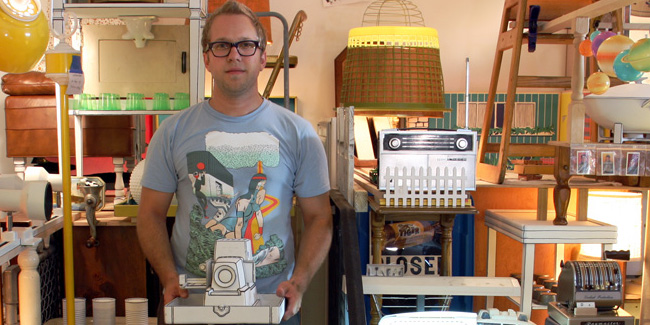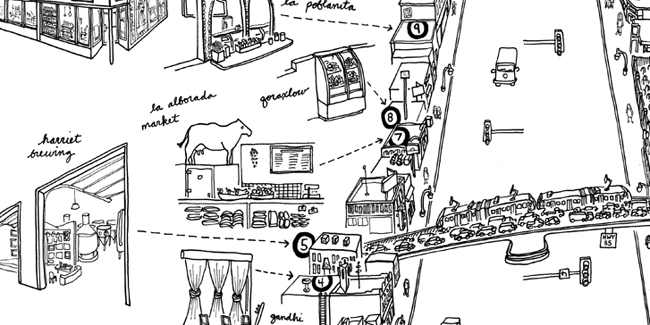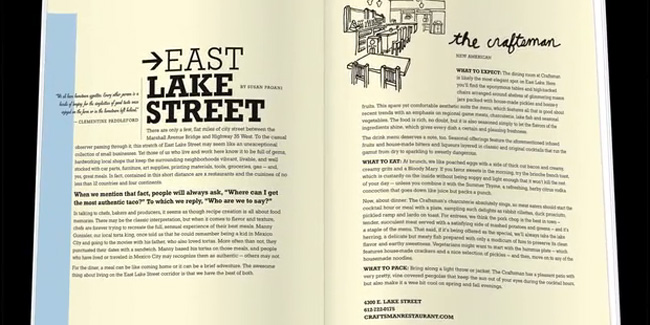
One day last winter, artist Andy DuCett and I spent a day wandering up and down Lake Street together, hopping over giant snow berms, and ducking into the dozen or so restaurants and shops included in The Secret Atlas of North Coast Food.
We’d only met once, and we’d never worked together, but we quickly developed a kind of routine that involved Andy nonchalantly getting whatever photos he needed — a life-size fiberglass cow or a chalkboard Eskimo — while I reassured the restaurateur that we were on the up-and-up and they would be featured in an upcoming book.
In short, it was not unlike most of my food-writing adventures, which generally involve collaborating with a photographer.
Yet the outcome was different. Food photography captures the meal and the aesthetic, mood, and ambiance of the place. Andy’s drawing went a step further, getting the whole street, but it also contained an extra layer of translation — his perspective, in which a pastry counter is bigger than a cow, which is bigger than building or a bus. Having been there with him, it was cool to see it all through his eyes.
Andy is a drawing, installation, and collage artist, who currently teaches at both Macalester College and The Minneapolis College of Art and Design. In this interview, Andy talks about perspective and how the project (which you can view and read here) has reshaped his relationship to Lake Street.
So, what’s appealing about a project like this for an artist like you?
So when somebody says they’re writing a food blog — or anything else that you can find on the internet, like a fashion blog or video game blog — it’s like yeah, yeah, get in line yahoo, there are 17 million other people online who are attempting to do those things. But the way that Heavy Table approaches the content, the writing, and what they choose to feature and review, has always had a really good sense about it. So when James said, ‘We’re going to be doing this book,’ I already knew it was going to be great because of what Heavy Table brings to the blog.
Some of the stories that they talked about at the initial meetings were also really exciting in the way that they were going to showcase the unique foods we have in the Midwest. It’s going to be a whole different approach to talking about how people are interested in and use food, where sometimes the story or the context or the situations are the most important thing, but they just happen to center around a food experience — maybe something as mundane as a campfire, but the catalyst kind of being these things that all stem from food bringing us together. So it’s a really neat idea, and I really want to be a part of it.
And then he paired me with this one writer and I was like, God, I’m not sure if I’m really interested, and then he twisted my arm.
I think he bought you breakfast …
I think he did. He bribed me with a Bloody Mary with a chicken skewer in it.
How well did you know Lake Street and these restaurants before we started working on this chapter?
I teach over at Minneapolis College of Art & Design, so I drive down Lake Street quite a bit. At the same time, I knew I didn’t know the restaurants well and even all the restaurants we went into — as rich and interesting and unique as the food and spaces and people were — were just a small section of the cavernous areas that inhabit Lake Street. A couple of the markets that we went into just seemed to go on forever, and as we kept winding our way back through those areas, there were dozens of little stands that looked just as fantastic as some of the places that we had profiled. So I quickly learned that I had no idea what was on Lake Street.

Even a place like Ingebretsen’s: I can’t believe that I haven’t spent more time looking at that place because even just the exterior is ridiculously great, just so beautiful and ornate and unique. So now, it’s like each place or shop has its own unique personality. It’s almost like surveying a crowd and then getting down into the crowd and shaking hands with each person and finding out how unique each one of them actually is. You could just go by and say, ‘Oh, there’s shops,’ but if you stop and investigate, you see how deep each of those experiences will go.
I really like how you used the word cavernous. There are all these layers of things happening on the street, and you can really see that in your drawing. It’s almost like a nesting box. So, when you said that, I wondered if that’s what you were thinking as you drew — that you were kind of layering back?
Well you know, whoever else brings a unique observation like that, I will also answer yes, absolutely, of course I was! It’s like I tell my students when I ask them, ‘Oh did you plan that? It’s absolutely brilliant.’ And they say, ‘No, I did not.’ The answer should be yes: Always take credit for the circumstantial genius that people detect in your work.
No, I think there was some of that. I did want to make it seem like that layered, sort of stack — like the way that the drawing just sort of proceeds off into space. All of the the things to the left, the callouts, defy that same kind of perspective. One is that it was pragmatic and I wanted to make it fill the page in an interesting, formal way. Two: That sort of stacking and that change in perspective and hierarchy sort of, I hope, approaches the same disorientation I felt when I was in some of those spaces that seemingly went on forever.
You know, I live a half a block off of Lake. There were restaurants that I’d been to and some that I’d always wanted to go to, but basically, I thought I knew it really well. But now, I feel like it’s my street. Now that you’ve drawn it, do you feel closer to Lake Street?
Oh, a hundred percent yes! So my wife’s family visited and we went to Parka during that monsoon rain that we had a couple days ago, and it felt a little more like home. Driving down it, I’ve felt a little bit more comfortable, more familiar and able to locate myself within that broader context of Lake Street.
It’s like when you look at a map of the Boundary Waters, all the different coordinates, topographical lines and little paths where you can portage between places — they all look so abstract. But when you’ve been there once or twice and you’re returning, you know the rocks that you’re going to step over, the campsite, where you’re going to tie your hammock, and where you’re going to sleep, and it contextualizes that experience. It’s the same thing with Lake Street, it’s a street on a map on a city that’s representative of this richer diversity of people and food and culture. I think this project was a really nice window to kind of, not demystify, but familiarize myself with the possibilities.
Click here to learn more and support this Kickstarter project.

